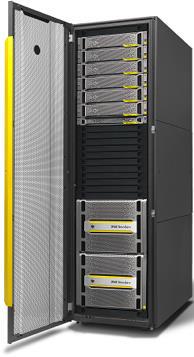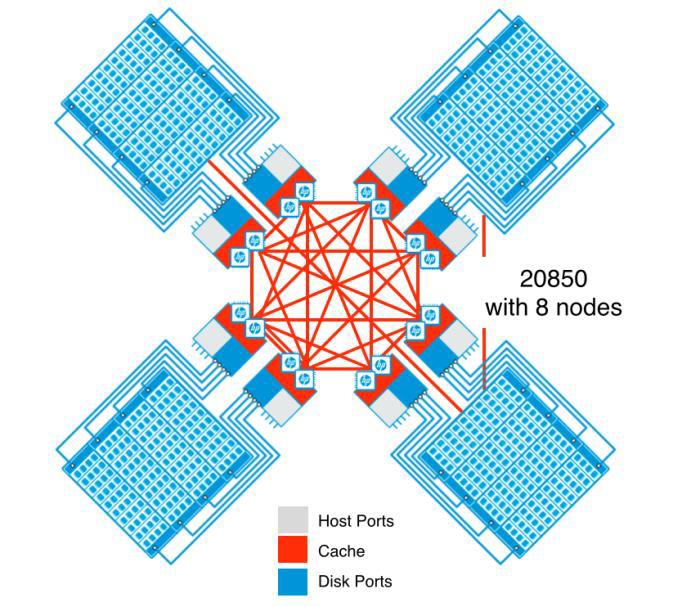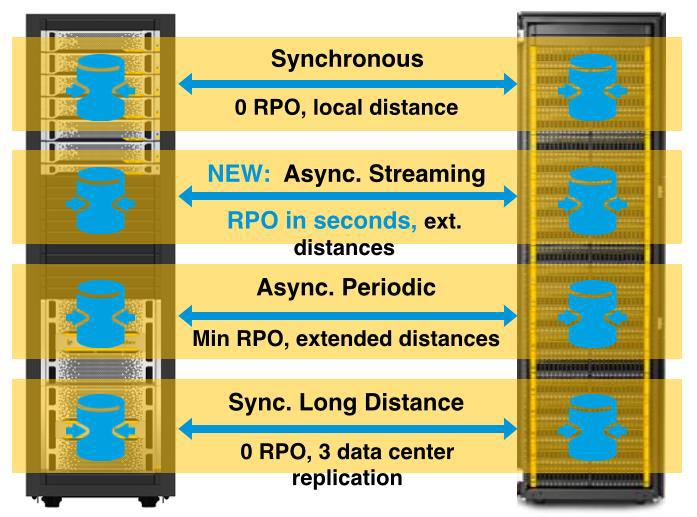Comparing the HP 3PAR 10000 with the new high-end HP 3PAR 20000 system
At the last HP Discover conference, the new high-end HP 3PAR 20000 system was announced (model 20800 supports both ssd and regular disks, and model 20850 supports only ssd). Compared to 3PAR 10000, there are quite a few changes (to mark this and the model number has changed 2 times), the system has become not only noticeably more productive, but also got rid of the rudimentary fiber channel as an interconnect between the controllers and disk shelves. Taking into account the fact that the “ten-thousand-year-old” has long been asking for retirement, I am even a little surprised that this announcement happened now, and not last year.

3PAR 20000 controller
')
At the heart of each 3PAR 20000 controller is 2 fifth-generation ASICs (Thin Express ASIC). Thanks to ASIC, high performance XOR operations for RAID operation, as well as low latency in an eight-node full-mesh system is achieved.

The 3PAR Persistent Checksum technology, introduced with the new generation of ASIC, provides T10-PI data integrity monitoring all the way from the physical media to the port connected to the host. The verification process is completely transparent to the host and does not affect system performance.
As in the middle class arrays (3PAR 7000), which uses 4th ASIC generations, such technologies as zero detection (“empty” blocks are not written to disk), thin deduplication (hardware data duplication based on hashes) are supported, as well as familiar to the owners of 3PAR systems thin provisioning. Note that unlike some other systems, when using deduplication, additional bit-by-bit data checking occurs to avoid hash collisions.
All these technologies allow optimal use of available disk resources, reducing the actual cost of storage. Marketing claims that the cost of storing data on flash by increasing efficiency (up to 75%) is approaching the cost of storing it on ordinary 10k hard drives.
Comparison of the model 20800 and 20850
In each 3PAR 208x0 system can be from 2 to 8 controllers. Model 20800 uses 2 six-core 2.5GHz processors, 96GB control cache and 128GB data cache. The 20850 model has 2 eight-core 2.5GHz processors, 128GB control cache and 256GB data cache. Hosts can be connected using Fiber Channel (16Gbps), 10Gbps iSCSI / FCoE, and 10Gbps ethernet protocols using File Persona.
Each controller has 7 PCI-Express slots for installing disk or host adapters. Disk shelves (24 2.5 ”disks or 12 3.5” disks) are connected to the controllers via a 12Gbps SAS interface (at least, therefore, shelves from 7000 systems cannot be used). It remains to hope that when the update for the current midrange generation comes out, the shelves will be unified, and you can try to save on the upgrade. Supports SSD drives with capacities from 480GB to 3.84TB (and this is 92TB in one shelf!), As well as all standard sizes of SAS / NL SAS drives (up to 6TB). The 12Gbps SAS interface supporting optical cables (up to 100m long) helped to use FC to connect the shelves. Model 20800 supports up to 1920 drives (of which 1024 can be SSD), 20850 supports up to 1024 SSD drives.
For the all-flash model 3PAR 20850, the performance is declared up to 3.2 million IOPs with a latency of less than 1 ms, which is quite an impressive result. Of course, we are also waiting for the publication of results on storageperformance.org and we hope that they will not take long to wait.
Another new array feature is Bi-directional Peer Motion. Now you can combine up to 4 systems together and transparently for the user to “move” the load between them, without using additional software or hardware virtualizers.
Asynchronous replication has been enhanced with the new Asynchronous Streaming mode, which provides RPO in a few seconds, rather than a few minutes as the classic Asynchronous Periodic mode. This may be relevant for those customers who cannot afford the synchronous replication mode due to the reduced latency, but want to minimize possible losses in the event of an accident.

Although the new array is positioned as a high-end, it clearly lacks the distinctive feature of these “giants”, namely, support for the FICON protocol and the ability to connect mainframes. Of course, HP has great XP7 storage systems for this, but it seems to me that they are offered to customers precisely as a last resort, when 3PAR cannot be sold due to fundamental limitations in the client's infrastructure.
In this regard, it is interesting to note that now HP 3PAR Online Import supports migration from HDS NSS, US and VSP systems. It seems to me that this is not just that.
Some conclusions
Owners of the previous generation (10000 series) will have to allocate new substantial budgets for migration to the new platform - due to the change of interconnect, a partial upgrade is impossible, so you have to change the entire system (and controllers and disks).
As you can see, the possibilities of the new 3PAR 20800 and 20850 are at the height. I am sure that these systems will find their customers in the very near future and will perfectly cope with the load. I think that we should expect the release of the updated midrange line of 3PAR, if not this year, then in 2016 for sure.
You can find the full version of the article in Trinity's blog :)

3PAR 20000 controller
')
At the heart of each 3PAR 20000 controller is 2 fifth-generation ASICs (Thin Express ASIC). Thanks to ASIC, high performance XOR operations for RAID operation, as well as low latency in an eight-node full-mesh system is achieved.

The 3PAR Persistent Checksum technology, introduced with the new generation of ASIC, provides T10-PI data integrity monitoring all the way from the physical media to the port connected to the host. The verification process is completely transparent to the host and does not affect system performance.
As in the middle class arrays (3PAR 7000), which uses 4th ASIC generations, such technologies as zero detection (“empty” blocks are not written to disk), thin deduplication (hardware data duplication based on hashes) are supported, as well as familiar to the owners of 3PAR systems thin provisioning. Note that unlike some other systems, when using deduplication, additional bit-by-bit data checking occurs to avoid hash collisions.
All these technologies allow optimal use of available disk resources, reducing the actual cost of storage. Marketing claims that the cost of storing data on flash by increasing efficiency (up to 75%) is approaching the cost of storing it on ordinary 10k hard drives.
Comparison of the model 20800 and 20850
In each 3PAR 208x0 system can be from 2 to 8 controllers. Model 20800 uses 2 six-core 2.5GHz processors, 96GB control cache and 128GB data cache. The 20850 model has 2 eight-core 2.5GHz processors, 128GB control cache and 256GB data cache. Hosts can be connected using Fiber Channel (16Gbps), 10Gbps iSCSI / FCoE, and 10Gbps ethernet protocols using File Persona.
Each controller has 7 PCI-Express slots for installing disk or host adapters. Disk shelves (24 2.5 ”disks or 12 3.5” disks) are connected to the controllers via a 12Gbps SAS interface (at least, therefore, shelves from 7000 systems cannot be used). It remains to hope that when the update for the current midrange generation comes out, the shelves will be unified, and you can try to save on the upgrade. Supports SSD drives with capacities from 480GB to 3.84TB (and this is 92TB in one shelf!), As well as all standard sizes of SAS / NL SAS drives (up to 6TB). The 12Gbps SAS interface supporting optical cables (up to 100m long) helped to use FC to connect the shelves. Model 20800 supports up to 1920 drives (of which 1024 can be SSD), 20850 supports up to 1024 SSD drives.
For the all-flash model 3PAR 20850, the performance is declared up to 3.2 million IOPs with a latency of less than 1 ms, which is quite an impressive result. Of course, we are also waiting for the publication of results on storageperformance.org and we hope that they will not take long to wait.
Another new array feature is Bi-directional Peer Motion. Now you can combine up to 4 systems together and transparently for the user to “move” the load between them, without using additional software or hardware virtualizers.
Asynchronous replication has been enhanced with the new Asynchronous Streaming mode, which provides RPO in a few seconds, rather than a few minutes as the classic Asynchronous Periodic mode. This may be relevant for those customers who cannot afford the synchronous replication mode due to the reduced latency, but want to minimize possible losses in the event of an accident.

Although the new array is positioned as a high-end, it clearly lacks the distinctive feature of these “giants”, namely, support for the FICON protocol and the ability to connect mainframes. Of course, HP has great XP7 storage systems for this, but it seems to me that they are offered to customers precisely as a last resort, when 3PAR cannot be sold due to fundamental limitations in the client's infrastructure.
In this regard, it is interesting to note that now HP 3PAR Online Import supports migration from HDS NSS, US and VSP systems. It seems to me that this is not just that.
Some conclusions
Owners of the previous generation (10000 series) will have to allocate new substantial budgets for migration to the new platform - due to the change of interconnect, a partial upgrade is impossible, so you have to change the entire system (and controllers and disks).
As you can see, the possibilities of the new 3PAR 20800 and 20850 are at the height. I am sure that these systems will find their customers in the very near future and will perfectly cope with the load. I think that we should expect the release of the updated midrange line of 3PAR, if not this year, then in 2016 for sure.
You can find the full version of the article in Trinity's blog :)
Source: https://habr.com/ru/post/260575/
All Articles